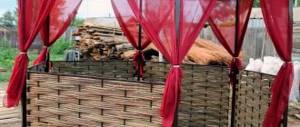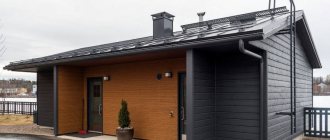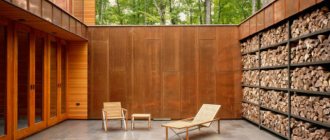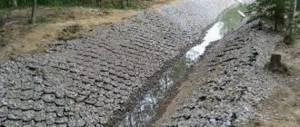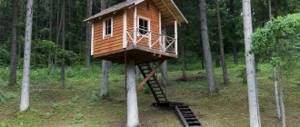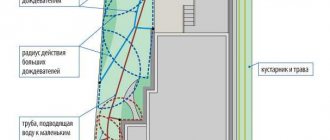Composition and proportions of solution for cinder block
There are basic recommendations for the composition of the solution for cinder blocks, based on which each individual craftsman and manufacturer creates their own unique and modified time-tested composition. This means a conscientious manufacturer who refines the composition to improve the properties of the block, and not with the goal of reducing the cost of production and making money on resale. The builder of his house will not harm himself and produce low-quality blocks. The composition given below is basic and suitable for making good quality blocks.
The recipe for slag concrete mortar (standard) has the following proportions:
– slag – 7 equal portions,
– sand - 2 portions, cement 1.5 portions,
– water up to 3 servings (you need to add enough water so that the solution is plastic, that is, when squeezed by hand, it retains its given shape or changes it smoothly and does not instantly spread)
– concrete plasticizer in a proportion of 5 g per cinder block. It is necessary to strengthen the product, increase frost resistance and increase water resistance. It would also be a good idea to add microfiber, which will further strengthen the bond of material in the block
– When making cinder blocks, both a private builder and a factory manufacturer can include other materials in the solution such as sawdust, gravel, gypsum, small broken natural stone and others. At the same time, the cinder block acquires additional properties and possibly disadvantages, so if you decide to experiment with the composition of the solution, read in the sources what properties the addition of one or another material to the mixture will give to the cinder block.
Arrangement of a cinder block base
If you want to build a cinder block plinth on a strip foundation, it is recommended to stock up on additional materials, which include:
- crushed stone, sand, cement material, gravel;
- steel reinforcing bars;
- plasticizers;
- cinder blocks;
- vapor barrier and waterproofing materials;
- insulation.
With this set you can ensure maximum strength of the structure being built and prevent the formation of cracks during subsequent operation. It is worth adding that the base itself for the object should protrude above the ground surface by at least seventy centimeters. This measure is needed to prevent water from being absorbed by the block material in the base.
The sequence of work is as follows:
- a trench is prepared, the bottom of which is filled with a sand and gravel cushion (25 cm for each type of material);
- The formwork structure is installed, the reinforcement frame is mounted. Everything is filled with concrete mixture;
- It is recommended to begin laying blocks seven days after the foundation is poured.
The height of the basement under construction should be three block rows, the lower of which is separated from the concrete base by hydro- and vapor barrier material.
Making a mold for cinder block
Without a special brick-making press, it is advisable to make cinder blocks if you have started a small-scale construction of a garage, summer kitchen, or bathhouse. To build a large house, you will need a large number of cinder blocks and the process of their production will take a lot of time and effort.
You can assemble the mold for pouring cinder blocks with your own hands. It is a parallelepiped with side dimensions of 40x20x20 cm. The given dimensions are again standard and you can change them at your discretion.
molds for cinder blocks with metal walls
The mold for pouring cinder blocks is often made from solid wooden boards; metal sheets can also be used. The boards should have a smooth surface for easier removal of the block. It consists of four side boards, that is, of two identical-sized pairs of boards, all four boards should be the same in height and a fifth board for the bottom of the mold. They also make molds without a bottom, but the floor of the room or street where the molds will be poured must be prepared, level, hard and clean. To speed up the process, they knock down and make a mold for several cinder blocks, 5-10 pieces at once, with partitions inside.
wooden molds
Set of tools for building a house
If you are planning to build a house with your own hands from cinder blocks, without resorting to the services of professional builders, then you simply cannot do without such a minimal set of tools
If you plan to build a house with your own hands from cinder blocks, without resorting to the services of professional builders, then you simply cannot do without such a minimal set of tools:
- Without the most important construction tool, namely without a trowel or “trowel” as it is also called in common parlance;
- Having a concrete mixer will also be very important. Of course, you can limit yourself to an ordinary tub, but you simply won’t be able to cope with large volumes of solution;
- When laying cinder blocks, sometimes small pieces of blocks will be required, so without a sawing tool nothing will work out - it could be a hacksaw, a circular saw or a grinder with a stone wheel;
- To plant blocks in the solution or level them, you will need a rubber or wooden mallet;
- To evenly smooth the mortar over a cinder block or when plastering walls, you cannot do without regular and serrated spatulas;
- Even during construction, plumb lines, a carriage and orders will be required;
- When working with an angle grinder or hammer drill, you will need goggles and a respirator.
We suggest you read: How to put a log bathhouse on a foundation
If it is possible to obtain scaffolding, then you should acquire it. They will greatly simplify the laying process. Otherwise you will have to use stepladders.
Pouring cinder block
– before filling the molds with solution, their walls must be lubricated with grease or soapy water
– after preparing the slag concrete mortar and forms, we proceed to filling them with the finished mortar. The molds must be filled with the solution evenly to the brim.
– glass bottles can be used as a means to create internal voids in the block. We stick bottles into the molds with the solution, neck up, remove excess solution and level the surface again. After about 5 hours, the bottles will need to be pulled out, otherwise, after the solution has completely hardened, they will not be able to be removed whole.
– a day or three after pouring, carefully remove the cinder blocks from the molds and lay them out on a dry horizontal surface and cover them with plastic wrap so that the material does not receive additional moisture from precipitation. The most suitable conditions for drying cinder blocks are from +20 to +25°C. We leave the cinder blocks in this state for 1 month until they fully gain strength.
After one month, new cinder blocks can be used for masonry.
In the next section below, we will not present the advantages and disadvantages of a house made of cinder blocks, relying on the specific features of cinder block as a separate building material and its convenience in construction, without linking it with other building materials into a single structure - a residential building, as most authors of publications on this topic do , but we will present the real pros and cons of a ready-made residential building whose walls are made of cinder blocks, which the owner encounters while actually living in such a house.
The pros and cons of a cinder block house are listed below, taking into account the fact that the house was built in compliance with the technology and the cinder block as the main material for the walls was also of proper quality. If the construction technology is not followed, as well as if defective material is used, in principle, as when building a house from any material, then problems during the operation of such a house can be unpredictable and significant.
cinder block house without facade finishing
Construction stages
You should start by choosing the right types of cinder blocks for the foundation. Hollow material will not suit us, but blocks filled with crushed stone will come in handy. This variety is characterized by maximum strength; everything else is adjusted using additional materials.
Taking into account the peculiarities of masonry work, the parameters of the blocks and other little things, one person can handle the construction of a cinder block foundation for a decent house with his own hands within a week. You just have to solve the issue of protecting the foundation from moisture, quickly erect walls and make a roof.
To equip the foundation for a house, you will need to follow a strict sequence of actions:
- first, a trench is dug and a bed of sand and gravel is laid;
- it is covered with roofing felt material in one layer. Instead, it is allowed to use bitumen or fiberglass.
When building a foundation from cinder blocks for a house with your own hands, you should understand that it must form a solid and durable structure, in which each element is connected with sand-cement mortar with a seam thickness of no more than one centimeter.
To prepare the mortar mass, use cement material M400, clean sand, and add clay or plasticizer components.
In most cases, the proportional relationship looks like this:
- cement - one share;
- sand - four shares;
- a third of the share of clay for every four is a sand-cement mixture.
The dry ingredients taken in the required quantities are mixed, then water is added. At the same time, mix the solution thoroughly to achieve the desired consistency and obtain a plastic mass.
Masonry work
Reinforced concrete blocks are installed on the roofing felt strip. On top of them, the first row of cinder block material begins to be laid out. Subsequent rows are laid out from the corners to the center; a solution is used to connect them. Reinforcement is performed on top of the last row.
We invite you to familiarize yourself with: Size of trim for interior doors
As soon as the main part of the cinder block strip foundation is completed, mastic is used, on top of which the insulating material is mounted. Water protection should be provided on each side to prevent its penetration into the blocks.
The trench is filled in and construction of the walls begins.
This is how the foundation for a wooden house is made. The design will fully support an object with two or even three floors. For a barn, greenhouse and other outbuildings, you can build simpler foundations - columnar foundations made of cinder blocks.
The cinder block is placed staggered into the foundation, moving from the corners to the central part of the row. Horizontal deviations are allowed, which should not exceed one and a half centimeters. The masonry is done in half a block, with one or two stones. This takes into account the size of the stone and the thickness of the walls of the foundation being built. Metal mesh is excellent for reinforcement.
Joining areas and seams are completely filled with mortar.
As with building a brick house, all corners must be carefully aligned. The end result should be a perfect rectangle shape. Then four cinder blocks are placed on the surface of the foundation. They are leveled with a building level and a stretched cord. After this, a layer of cement mortar is applied to the surface.
The blocks are laid down very simply. There are very few differences from brickwork. The solution is applied with a trowel. The stone is placed at an angle to the surface, turned so that it is parallel to the surface of the wall, and pressed tightly against the stone that was laid earlier. In this case, you need to lightly tap the concrete block with a hammer. Excess mortar residues are removed with a paint trowel.
The very first rows must be laid out as accurately as possible. When erecting them, you need to use a building level and a plumb line to check how smooth the surface is. The more often you carry out this check, the faster the work will go. In addition, you will not have to correct any mistakes made.
Pros of a cinder block house
– high strength of the structure, which is achieved due to reinforced walls, good adhesion of porous cinder blocks with cement mortar to each other. Such a house will withstand any hurricane and almost any earthquake
– absolute fire safety, cinder block walls cannot be set on fire when exposed to high temperatures, or when directly exposed to fire for any period of time. Since the cinder block does not contain flammable components at all, and even on the contrary, the cinder block already consists of the end products of combustion. External finishing of the facade, such as siding, and other flammable materials can burn completely, but the walls of the house will remain in place and will not lose their strength and structure. This also applies to a fire inside a building.
cinder block walls do not burn and are not destroyed during a fire
– Insects and rodents do not live in cinder block houses for permanent residence. They cannot create nests for themselves in such walls and will multiply.
– with technically correct insulation, it retains heat and cool well in the hot season, just like brick houses.
– there is good sound insulation inside the house, you don’t have to worry about noisy neighbors and busy streets if such a house is being built in areas with high traffic or near highways.
it is necessary to insulate the facade of the house
– in cinder block houses, or rather on the walls inside and outside the house, fungus does not grow, that is, the walls of the house are not susceptible to biological damage. This property is due to the composition of the material.
– durability of a cinder block house. The service life of such houses has been verified by real time; to this day, buildings made of cinder blocks that are 100 years old still stand and are in use.
What can reduce the advantages of cinder block houses, and how to solve problems with disadvantages
Construction material made from industrial waste has its advantages and disadvantages. Before you make a choice in its favor, carefully study all sides of the coin.
ProsCons
| Suitable for the construction of low-rise residential and commercial buildings. | A long period of formation of blocks during the manufacturing process. |
| Wide range of applications due to the variety of block types. | Masonry made of this material shrinks after a few months. |
| Excellent heat-saving data, allowing the blocks to be used for construction even in the Far North. | Blocks may crack during laying. |
| This building material is easily cut into pieces. | High strength material requires additional insulation. |
| Hollow blocks significantly reduce the load on the foundation. | |
| High fire resistance, resistance to moisture and fungal growth. | Simple manufacturing technology has led to the appearance of low-quality material on the market. |
| The excellent vapor permeability of the blocks helps create a comfortable indoor climate. | |
| This building material is one of the cheapest. | The use of waste from boiler houses and blast furnaces makes this building material environmentally unsafe. |
| You can make cinder blocks with your own hands. |
Think before you decide to build with cinder block. Such houses require additional protective measures; their construction should be kept under strict control, taking into account the shrinkage and self-destruction of the blocks
We found out what cinder blocks are and their advantages and disadvantages. How to make the most of the useful qualities of this building material and minimize losses? The main way is to choose the right product, avoiding widespread defects. How to do it:
- Buy blocks only from a reputable seller. Such a retail outlet must have quality certificates for the product indicating all its technical characteristics.
- Find out what filler is used in the production of blocks. Do not buy material with granite screenings for residential buildings; it may have an increased radioactive background.
If possible, check the product with a Geiger counter.
- A high-quality block must have clear geometric shapes. Carefully inspect the batch for cracks and chips, selectively measure several elements to see if they correspond to the declared parameters.
- A simple test of the block’s strength is to stick an ordinary nail into it. If the nail goes in without using a hammer, don't buy it. Try to manually break one product - if the production technology is violated, the blocks crumble with little effort.
- Transport purchased building materials only on pallets.
Build a secure shed to store blocks
A cinder concrete house has many advantages, and the main one is its cost. During operation, you will appreciate the comfortable climate and warmth, ease of decoration and repair. The main thing is to choose high-quality material and check it for background radiation.
Cinder block is an ideal solution for a small dacha and a full-fledged country house
Characteristics and sizes of different types of cinder blocks
Different types of fillers and shapes divide blocks into several main types. Some of them are suitable only for the construction of garages, fences and other outbuildings. There are blocks that are used for insulation or cladding, and there is a high-strength material that can withstand heavy loads. How not to make a mistake in this diversity?
A solid element made of filler and cement fill is characterized by increased strength. It can be used in any load-bearing structures: supports, foundations, columns and basement structures.
This material is not used for the construction of walls, as it has low thermal insulation characteristics
Foundation blocks made of slag concrete are especially in demand. But you need to remember that they can shrink and need reliable protection from the effects of groundwater.
Blocks can have voids in their structure - oval, round, square or rectangular. The size of such voids is approximately a third of the volume of the building element.
Such blocks are used for internal partitions and load-bearing walls.
The most common question is: how many bricks can fit in the volume of a cinder block? Standard block dimensions: 39x19x18.8 cm. Thus, there are approximately 6 single bricks in one volume. If we compare the thermal conductivity of the material, then one block is equal to 12 bricks.
Decorative cinder blocks are rarely used - there are a lot of other materials for facade finishing that look more presentable
Making cinder blocks yourself (photo, video)
Making cinder blocks yourself (photo, video)
Cinder block is a building material made from a special concrete mixture by vibrocompression.
Buildings made from this material are warm, the construction process is quite simple and does not take much time. Thanks to this, cinder blocks have become very popular in private construction. In addition, you can build a very profitable business on cinder blocks. To do this, you need to have a special recipe and production technology, and also try to automate the process of making cinder blocks with your own hands at home. Cinder blocks can be either hollow or solid. Solid cinder blocks are most often used for exterior cladding and foundations, as they have excellent strength characteristics. In turn, hollow cinder blocks can provide good sound and heat insulation of walls. In addition, thanks to the voids, the consumption of raw materials can be significantly reduced, which will affect the cost of production. The strength characteristics fully satisfy all requirements. Hollow blocks in which slag (cinder blocks), expanded clay (expanded clay concrete blocks) or sawdust (arbolite blocks) are used as filler. Such blocks have very good heat-insulating properties, which allows them to be used as insulation. By using the thermal insulation blocks described above in construction, you can make the walls of a building warmer without increasing their thickness. These blocks are significantly larger than the size of ordinary bricks, making construction work much faster and easier, and mortar is saved during laying. When using fillers, which are most often free, you can significantly reduce the thermal conductivity and cost of products, as well as increase their strength characteristics. Advantages and disadvantages
The advantages of this building material include the following:
- It is possible to make cinder blocks with your own hands at home.
- There are various techniques. The material, in addition to autoclave treatment, can be dried by steam treatment or at room temperature.
- The building will have minimal heat loss.
- Short construction period and low cost. The walls are erected very quickly due to the large size of the blocks. In addition, the consumption of the solution during construction is quite small, which saves time on its preparation.
- By changing the proportions of the recipe when making cinder blocks, you can endow the products with certain properties that are necessary for their use.
- You can produce products of any shape and size, which is very convenient. In addition, this can often make installation much easier.
But cinder blocks, like any other material, have some disadvantages:
- The environmental issue is quite pressing, especially with regard to products containing blast furnace slag.
- Quite low frost resistance.
- The material requires enhanced protection from moisture.
- Cinder blocks are quite fragile and therefore not suitable for foundation installation. Even when erecting walls, it is necessary to take into account the load and height of the future building.
Application
Most often, cinder blocks are used for the construction of low-rise buildings, but according to some data, cinder blocks can also be used to build a foundation if they contain “high” grade cement. Cinder blocks can act as additional insulation during the construction of frame structures. General requirements High-quality cinder blocks can be made even in a garage, provided that you know the recipe and manufacturing technology. A standard cinder block has dimensions of 39x19x20 cm and three small holes.
In order for the cinder block to be of high quality and have the necessary strength, you will need:
- vibropressing equipment;
- high-quality cement (not lower than M400);
- blast furnace slag;
- coarse sand.
Slag is obtained during coal processing, that is, it is the best filler for blocks. But nowadays, due to the active use of gas, ash and slag have begun to be produced in much smaller volumes. Therefore, more and more often, slag is replaced with zitoconcrete, which has a higher cost. This building material is now becoming more and more popular due to its low price and excellent sound and heat insulation. In addition, calculations show that when making cinder blocks with your own hands, for one block you will need 0.011 cubic meters of solution (if you use a 1:7 ratio), that is, a bag of cement will be enough for you to produce 36 blocks! This is simply a great result. High-quality cinder blocks must have the most accurate geometry possible, since if there are various flaws and large irregularities on the surface of the blocks, you will have to spend a significant amount of money on the construction of the walls of your building. In order to get a perfectly flat cinder block, you must always fill the vibroform to the very edges, since otherwise the blocks will be crooked. It is advisable to fill the vibroform not even to the brim, but with a reserve, since then the concrete will be slightly shaken by vibration. The production process is as follows: first, the vibrating mold is turned on for 5-15 seconds, after which it is necessary to evaluate the level of the solution in the mold. If it ends up below the edge of the mold, you will need to set the clamp and turn on the vibration again. You need to turn off the vibration when it hits the limiter. After this, you will need to simultaneously pull out the form and turn off the vibrator. How to fill the form? If you want to set up your own production of cinder blocks, you must remember that the ideal composition simply does not exist, since each master has his own unique recipe, depending on the slag available and suitable for specific needs. But there is a certain standard, according to which cinder blocks have the following composition: 1.5-3 parts water, 1.5 parts cement, the grade of which should not be lower than M400, 2 parts sand and 7 parts slag. As mentioned above, a standard cinder block has dimensions of 39x19x20 cm, while in private construction dimensions of 40x20x20 cm can be used. In addition to slag, other coal combustion waste, as well as broken bricks, gypsum, granite and stone screenings, and perlite can be used as a filler for blocks. , processed sawdust, gravel and ash. In order to achieve greater plasticity, you can add 5 grams of plasticizer per block during vibration casting. The plasticizer can significantly increase the strength of the block, eliminate cracks, and also increase its water resistance and frost resistance. Be very careful with the amount of water, make sure that the blocks do not spread when removed. To be more confident, you can test the solution - if it comes together in your fist, but crumbles when dropped, then this is what you need! The concrete that will be required for the construction of a small private bathhouse can be prepared manually yourself, and if you are planning to build a larger facility, then you will need an electric concrete mixer with a volume of about 0.2-0.5 cubic meters. Manufacturing process
It is not recommended to make your own cinder blocks outdoors. It is best to work in a well-ventilated area with a level floor. To get high-quality cinder blocks as a result, you need to follow these steps:
- At the very beginning, you need to put a solution into the mold with a slide and turn on the vibrator for 3-5 seconds to precipitate the solution. If the solution is not enough, it should be reported. After this, you need to insert the clamp and start the vibrator again. When the clamp reaches the limiter, the formation of the block will be completed.
- Next, you need to carefully remove the form, including the machine.
- The finished blocks need to be dried for about 5-7 days, and they will reach complete hardening, being in heat and high humidity, only after a month.
- You can carefully move the blocks without fear that they will break within a day, but you can store them together only after a week. If you added a plasticizer when creating the blocks, then they can be transported and stored in 6-8 hours.
Most often, finished cinder blocks are stored in pyramidal stacks, each of which can contain about a hundred blocks, with small spaces between each other for good drying. After a couple of months of drying, these blocks become suitable for construction. Manufacturing a vibrating machine Manufacturing a cinder block machine
If your goal is to build one small building, for example, a bathhouse, then you can produce blocks in ordinary carrying boxes. If you are planning to build a larger object, then you will most likely need a machine that may not have a vibrating plate and may be homemade. Moreover, the production of blocks can drag you down and you may want to open your own business, which will require you to automate the process. In addition, after building a bathhouse, you can build a nice barn, a beautiful gazebo or even a garage. If you have a hand-made vibrating machine at hand, you can use it to save a lot of time.
In order to make a machine for producing cinder blocks with your own hands, you will need:
- fittings having a diameter of 12 mm;
- sheet iron having a thickness of approximately 3 mm;
- grinder and electric welding;
- a high-speed engine with a power of approximately 0.5-0.7 kW, which must have two shafts.
When making cinder blocks with your own hands, the vibration time is only 5-15 seconds. Then the vibroform is removed and after a day the cinder blocks can be stored. Using a simple home machine, you can make approximately 50 cinder blocks per hour, which is a pretty good result.
16.12.2014
See also:
- Device for making cinder blocks (drawings and diagrams)
Rate a homemade product, a master class, an idea. Comments
